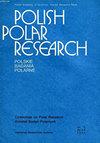冰岛Krafla地热活动熔岩区苔藓植物中的缓步虫和甲虫螨及真缓步虫目Pilatobius islandicus sp. 11 . (Eutardigrada)的描述
IF 0.8
4区 地球科学
Q4 ECOLOGY
引用次数: 11
摘要
在极地地区,除冻土带和冰川外,气温升高的地热活动区是生态系统的重要组成部分。冰岛就是这样一个地热活跃的地区,其特征是马赛克生态系统和大片新近被熔岩覆盖的地区。本研究的目的是探索冰岛克拉夫拉地区地热活动熔岩区的无脊椎动物多样性。在温暖地表采集了8份苔藓植物样本,主要来自蒸区。我们在样本中发现了线虫、轮虫、缓步虫和甲虫。生境分析表明,该区有苔藓植物12种(苔类5种,苔藓类7种)。单样苔藓植物的多样性在1 ~ 6种之间。最常见的苔藓植物是蓝齿藓(Racomitrium lanuginosum)。Brid。他们发现了四种缓步动物,其中一种是新发现的。本文通过形态学、形态计量学和分子方法(COI, 28S rRNA, 18S rRNA)对岛彼拉多ius islandicus sp. 11进行了描述。甲螨鉴定为Malaconothrus monodactylus (Michael, 1888)和Camisia foveolata Hammer(1955)两种。无脊椎动物平均密度为13.1 ind./g,最大密度为40.8 ind./g。本研究发现的缓步动物属于食草动物、微生物动物和杂食动物,而螨虫属于腐食动物,这表明在地热活跃的熔岩场中存在复杂的营养网络。本文章由计算机程序翻译,如有差异,请以英文原文为准。
Tardigrades and oribatid mites in bryophytes from geothermally active lava fields (Krafla, Iceland) and the description of Pilatobius islandicus sp. nov. (Eutardigrada)
In polar regions, apart from tundra and glaciers, geothermally active areas with elevated temperatures are important elements of ecosystems. One such geothermally active region characterized by mosaic ecosystems and vast areas covered by recent lava fields is Iceland. The aim of our study was to explore the diversity of invertebrates inhabiting geothermally active lava fields in the Krafla area (Iceland). Eight bryophyte samples were collected from a warm surface, mainly from the steaming areas. We have found Nematoda, Rotifera, Tardigrada and Oribatida in the samples. Habitat analysis demonstrated there to be 12 bryophyte species (five liverworts and seven mosses). The diversity of bryophytes in a single sample ranged from one to six species. The most common bryophyte was Racomitrium lanuginosum (Hedw.) Brid. Four species of tardigrades were found, including one that was new. Pilatobius islandicus sp. nov. is described herein by morphological, morphometric and molecular approaches (COI, 28S rRNA, 18S rRNA). Oribatida mites were identified as two species (Malaconothrus monodactylus (Michael, 1888) and Camisia foveolata Hammer, 1955). The average density of invertebrates was 13.1 ind./g with a maximum of 40.8 ind./g calculated per dry material. The tardigrades found in our study belonged to herbivores, microbivores and omnivores, whereas the mites belonged to saprophages, which indicates complex trophic networks in geothermally active lava fields.
求助全文
通过发布文献求助,成功后即可免费获取论文全文。
去求助
来源期刊

Polish Polar Research
ECOLOGY-GEOSCIENCES, MULTIDISCIPLINARY
CiteScore
2.00
自引率
7.70%
发文量
0
审稿时长
>12 weeks
期刊介绍:
The quarterly Polish Polar Research edited by the Committee on Polar Research of the Polish Academy of Sciences is an international journal publishing original research articles presenting the results of studies carried out in polar regions.
All papers are peer-reviewed and published in English.
The Editorial Advisory Board includes renowned scientist from Poland and from abroad.
 求助内容:
求助内容: 应助结果提醒方式:
应助结果提醒方式:


